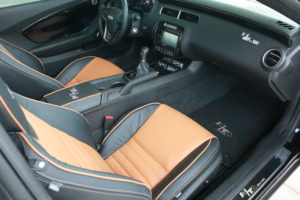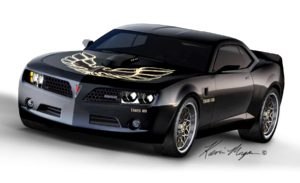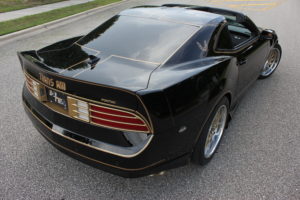Photos courtesy of Trans Am Depot; Rendering Kevin Morgan; First Published in Tail Fins and Chrome Magazine
Since its introduction in 1969, the Trans Am has set higher standards for cars of its kind. The firebird itself originated in 1967 as a consolation prize for Pontiac. However, GM didn’t want it to compete with the Chevrolet Corvette and so the decision was made to give Pontiac a piece of the pony car market, sharing the F-body platform with the Camaro.
The Trans Am specifically was first offered in 1969 as an optional handling package for the Firebird and named after the Trans Am Series. The package included a rear spoiler and had the option for Ram Air IV. Over the years, the package often offered extra styling along the body and wheels, as well as engine and suspension enhancements.
The extra power of the early 70’s big block engines was both a positive and a negative. Consumers craved the Trans Am in 1979 for its big power as well as its star power from the Smokey and the Bandit movies. However, that extra power meant extra emissions. So in 1980 when emissions restrictions increased in areas like California, large displacement engines were dropped.
Two fuel crises brought about several changes for the third generation Firebird Trans Am and Camaro, primarily in the way of smaller engines and less weight. It was this third generation car that was featured in the 80’s television show Knight Rider. In 1993, the fourth generation F-body was revealed, but by this time sales were declining. Trans Am production years ran from 1969 through 2002 when the last Firebirds were made.
With no more models after 2002, Trans Am enthusiasts and brothers Tod and Scott Warmack began restoring older model Trans Ams in Tallahassee, Florida. Pretty soon, several other family members bought Trans Ams as well. “It started with restoring cars and competing year after year at a national level,” he says. Tod says, “My brother would spend fifteen hours sanding pits out of a drive shaft.” It’s that fine attention to detail that helped them achieve multiple wins at the Trans Am Nationals.
The brothers owned Half-Time Enterprises, a sports marketing company that distributed licensed sports team merchandise. But in order to produce the parts they couldn’t buy, the brothers added automotive licensing to their company.
In 2006, just four years after the last Trans Am production model was made, some images of a newer model Camaro became public and circulated on the internet. That’s when graphic designer Kevin Morgan began dreaming about a newer model Trans Am. So he designed his own concept car and posted images on the internet that went viral, images that were even published in Hot Rod Magazine.
One day while driving home and thinking about Morgan’s concept car, Tod thought, “Why don’t we build that? We could purchase a new Camaro and strip it all the way down and replace the components. After all, this is how GM produced them.” Trans Am has always shared the same F-body with the Camaros.
The Warmack brothers had already met Kevin Morgan at the Trans Am Nationals in Dayton, Ohio while showing their cars, so they sought him out again in 2008 because there was no indication that the Trans Am would be going to market. They asked the simple question, “Would you be interested in us finishing your story?” Tod says that he wouldn’t have felt right if Kevin wasn’t involved. After all, it was his design. Kevin agreed and shepherded the design all the way through.

Some of the options available for the engine are a supercharger, twin turbo, and stainless headers.
That first conversation between Tod and Kevin happened in April 2008, and by September they had worked out a prototype design. Starting with a black Camaro from California, they revealed their prototype at the 2009 Trans Am Nationals, causing quite a stir among enthusiasts.
“By today’s standards,” says Tod, “I wouldn’t drive that first prototype down the street.” Each year has brought refinement. By 2011, orders started coming in which thrust the brothers into automotive manufacturing. So they sold their sports licensing company and concentrated on the Trans Am builds full time.
The Trans Am name is thought to be owned by General Motors; however, GM never owned it. They operated under a licensed agreement from 1969 to 2002 with Sports Car Club of America (SCCA) who owns the name. The Warmack brothers contacted the SCCA to license the moniker and succeeded, forming their new company: Trans Am Depot.
Besides GM, Trans Am Depot is the only company ever granted a license to use the name. Warmack and his crew take that privilege seriously. “They made sure we put out a product that would maintain the quality and integrity of their name. To be considered for that, and to be the only actual company other than General Motors that’s acquired brand exclusivity, is nothing short of historical,” he says.
One of the company’s most notable projects is the Kevin Morgan-designed Hurst Trans Am. Thanks to a partnership with Hurst Performance Vehicles, they have three editions: white and gold, black and gold, and silver and black. The black and gold Hust-edition was displayed at the 2012 SEMA Show and named one of Motor Trend’s Top 10 Favorite Rides. It started its life as a Camaro SS, but given the Smokey and the Bandit look with modern performance upgrades. Special features of the limited Hurst conversion packages include a RTM OE-style shaker hood, forged Hurst deep-dish five-spoke wheels, a three-piece rear spoiler, Hurst shifter, side skirt ground effects, and custom sill plates.

The interior of the Hurst edition includes a Hurst shifter, custom sill plates, Hurst dash plaque, “old-school” leather seats, Hurst embroidered floor mats, and refaced 1978-style gauges.
Trans Am Depot pays attention to every detail, disassembling the car all the way down to the frame and then giving it performance and suspension upgrades. Everything is put back together and dry-fitted before receiving paint. Once painting is complete, the car gets reassembled and tested. If you want a Trans Am today, you need to order one special from their shop, but be prepared to wait as the average turnaround on a conversion is six months, longer depending on the custom features ordered.


Recent Comments